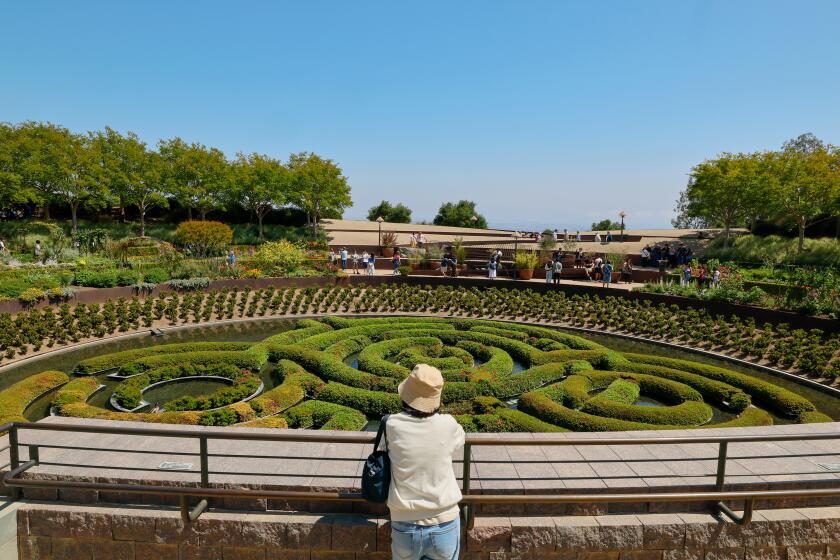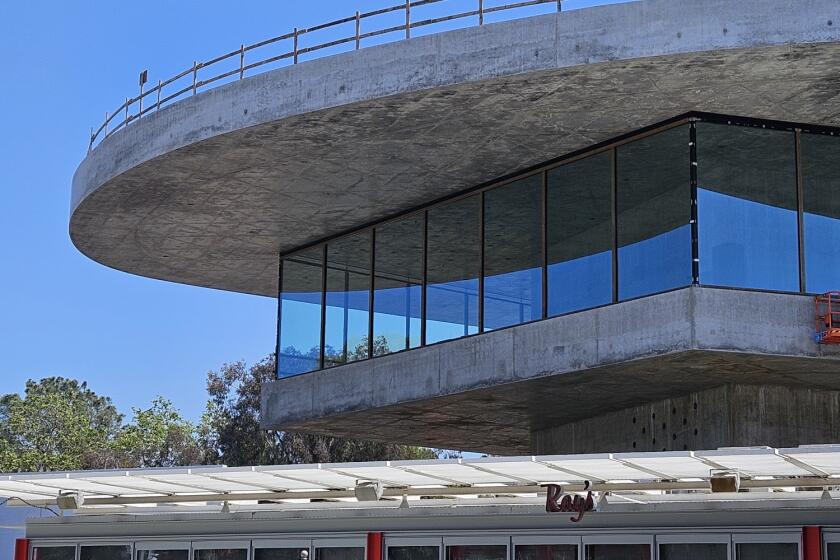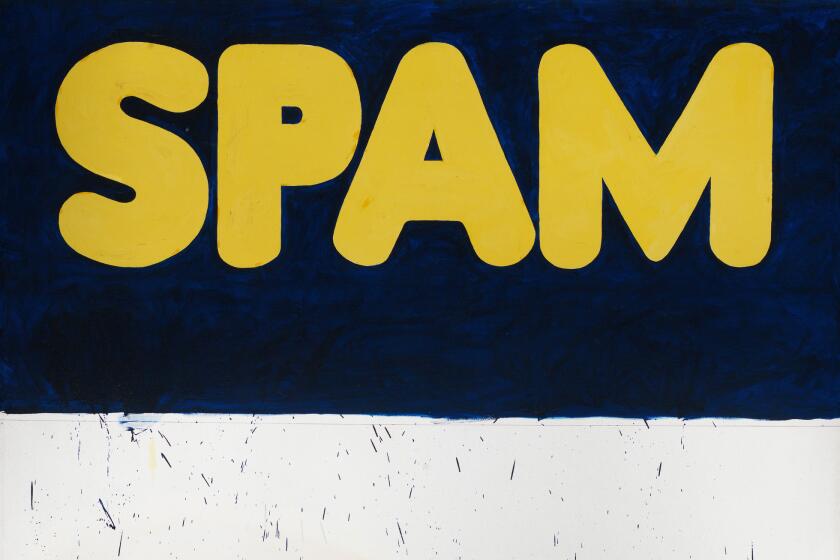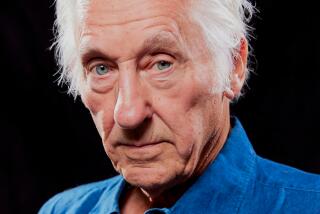Review: Eddie Rodolfo Aparicio sculpture will forever change how you see L.A.’s sidewalk ficus trees
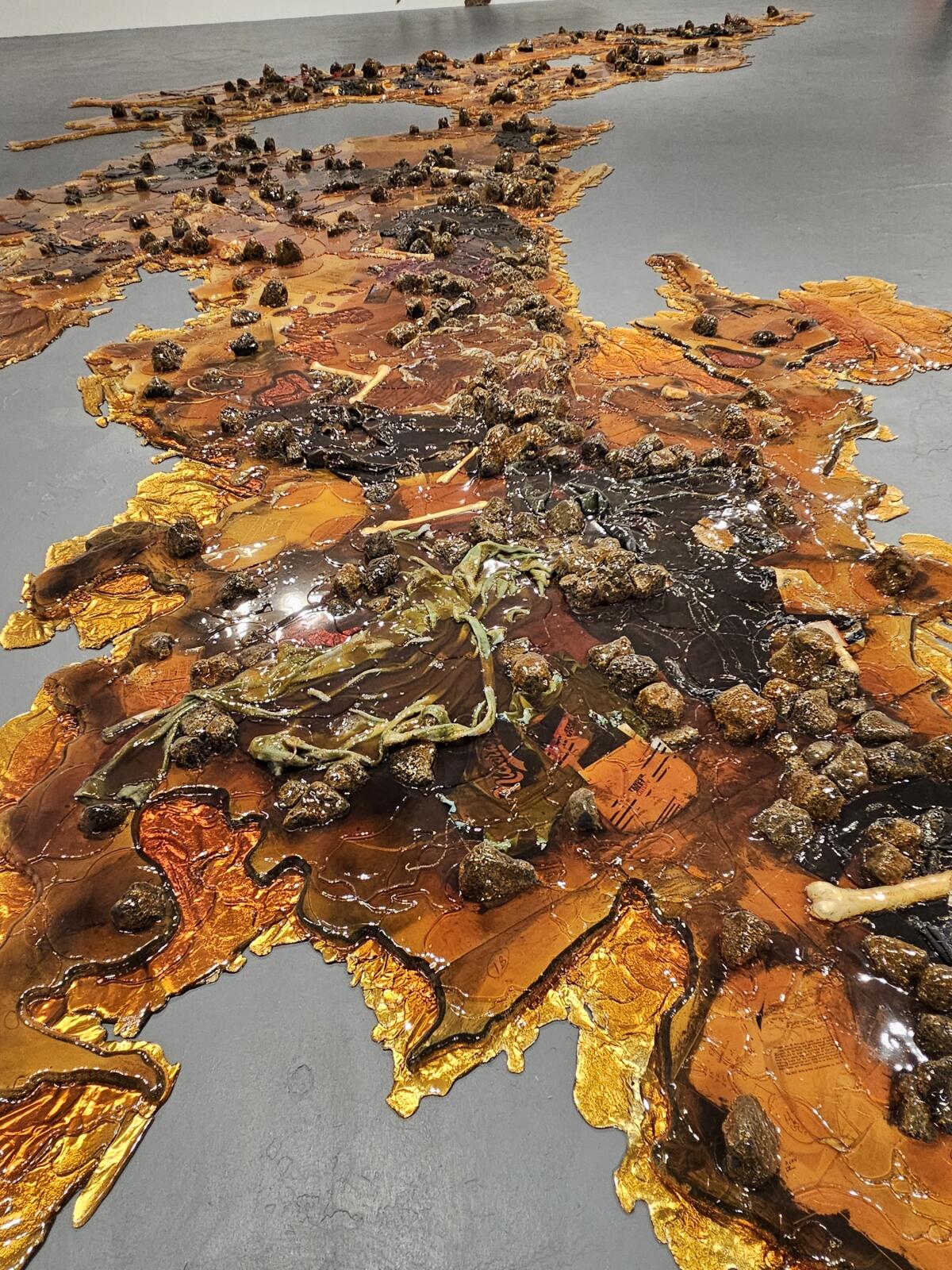
- Share via
Some of Eddie Rodolfo Aparicio’s sculptures are suspended from the ceiling or are hanging flat against gallery walls, the scruffy thinness of their sheets of rubber or latex material yielding an impression of flayed carcasses or maybe burial shrouds. Others, fabricated from translucent amber resin that has hardened to a glossy sheen, are low and horizontal, oozing and puddling across the floor like pools of blood or toxic spills.
An aura of disaster, death and decay is omnipresent in the artist’s solo exhibition at the Museum of Contemporary Art’s Geffen warehouse in Little Tokyo. But so, surprisingly, is a quality of determined endurance — and even elegance. Aparicio finds beauty amid the ruin. His art engages serious social and political experience, but it succeeds by its refusal to be monolithic.
The show, organized by MOCA’s Anna Katz and Anastasia Kahn, is the first in the revival of the museum’s dormant “Focus” series on emerging artists. (Aparicio was born in 1990 in Los Angeles, where he still works.) Modest in size, it includes fewer than a dozen works made since 2016. Key to them are the lists of materials dutifully identified in accompanying wall labels. For example: “Cast rubber, with ficus tree surface residues on canvas; glass; twine; and wooden support.” That list accompanies an unkempt, dun-colored polymer sheet, roughly 8 feet tall and 4 feet wide, edged with stitching that holds small green shards of broken glass.
L.A.’s most popular art museum can be overwhelming. Critic Christopher Knight offers his favorites: must-see paintings, sculptures and more, and what to know about each.
Something’s gone missing. Aparicio made the work by slathering a tree trunk with liquid rubber, letting it dry, then peeling it off and laying it flat. The living ficus that gave the sculpture its form is absent.
What hangs on the wall is, in effect, a matrix or shell. The jagged glass shards sewn with twine along the edges are like those vernacular security measures sometimes taken to prevent an invader from climbing over a wall. The implication here is that what’s missing may have been stolen. The theft is history.
The title “Who Do You Believe More, the Subversive or the Embassy? (W. Washington Blvd. and Hoover St., Los Angeles, CA)” features a parenthetical aside that might help explain. A major street intersection in Pico Union, where the ficus was cast, suggests a location for implicit theft. It identifies the heart of the city’s El Salvadoran community, which includes the artist among its numbers.
LACMA’s collection will be loaned to a new Las Vegas art museum. The deal isn’t a jackpot for L.A., which has long been promised its own satellites.
Like West Africa, El Salvador is a past source country for the production of rubber, essential to an industrializing Europe’s historic colonizing abroad. Ficus benjamina, which lines nearby thoroughfares, is an imported type of tree, native to Asia and Africa. Its common name is weeping fig, and in these flayed skins the lamentation resonates.
Aparicio’s particular choice of tree, an ordinary feature of the city everywhere you look, turns out to be a global evocation of all of multicultural L.A. A ficus canopy provides welcome shade from blazing sun above, while invasive root systems tear up concrete sidewalks below. Difficult memories of the city’s immigrant and migrant worker past are evoked.
The title’s reference to choosing between “the subversive or the embassy” — rebel or establishment — also cleverly implicates artists, whose conflicted role in modern society is to somehow bridge the two. Like any artist, Aparicio doesn’t stand outside daily life.
That inherent discord might also describe the pointy cones of glazed ceramic that stud “The Ceiba Saved Me.” The cones look like chunky thorns. These quietly menacing forms dot a much bigger rubber skin, cast from a different kind of tree, plus the white museum wall around it. The Ceiba occupies a central position in various Mesoamerican mythologies, while the imposing tree’s thorns turn up as ritual decoration on ancient Maya incense burners and burial urns.
Rags and cast-off clothing are embedded in some of Aparicio’s hangings. (The shapes look almost like maps.) Similarly, in the floor works, the golden brown puddles of flowing amber, a fossilized tree resin made extra sparkly with an underlining of what appears to be silver or gold foil, are peppered with bits of refuse — cigarette butts, pizza boxes, auto fresheners, newspaper clippings, soda cans, bones, rocks and more.
The meandering spill begins to suggest a difficult river crossing — the Rio Paz, perhaps, which forms part of the border between El Salvador and Guatemala, or the Rio Grande dividing the United States and Mexico. The glittering sculpture creates a shifting boundary between bright hope and poignant loss.
The LACMA show ‘Ed Ruscha / Now Then’ is the first comprehensive retrospective in more than 20 years of a quintessential American artist.
Titled “601 sq. ft. for El Playon,” it’s also a memorial to the brutal Salvadoran Civil War (1979-1992). The specific shape derives not from a river but from a volcanic gash in the earth outside the capital, San Salvador. El Playon, the war’s ruefully named “playground,” was used as a clandestine site to dump dead bodies. The volcanic roiling of inner earth merges with political churning aboveground.
Aparicio’s poetic sculptural forms look back half a century to the Post-Minimal art of the 1970s — especially process art, in which predetermined and accidental methods of their making replace personal decisions as the chief driver in creating the form. Robert Overby‘s full-scale latex casts of ordinary L.A. architectural facades come to mind, as do Lynda Benglis’ floor-bound Day-Glo pours of liquid rubber latex, made in New York.
But the difference here is significant. Aparicio coaxes cultural histories from his rubber casts of trees and meandering flows of poured amber. They remind me of controversial painter Gerardo Murillo Coronado, the legendary Dr. Atl, whose pictures used volcanic terrain as a metaphor for Mexico’s surging power and disorderly chaos during and long after that nation’s 1910 revolution.
Nature is scrutinized as an index of American culture. The landscape view subtly shifts. After seeing Aparicio’s show, you’re unlikely to look at our omnipresent ficus trees quite the same way again.
Eddie Rodolfo Aparicio
Where: Geffen Contemporary at MOCA, 152 N. Central Ave., L.A.
When: Thursday-Sunday, through June 16
Admission: Free
Info: (213) 626-6222, moca.org
More to Read
The biggest entertainment stories
Get our big stories about Hollywood, film, television, music, arts, culture and more right in your inbox as soon as they publish.
You may occasionally receive promotional content from the Los Angeles Times.
